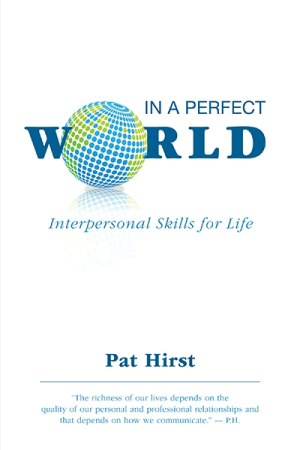In a Perfect World
Interpersonal Skills for Life
Hirst covers often overlooked principles to offer a fresh perspective to those struggling with derailed social lives.
Poor communication skills can severely strain personal and professional relationships. In her book, In a Perfect World: Interpersonal Skills for Life, speaker and mediator Pat Hirst describes many of the most common mistakes made during everyday interactions and offers advice on remedying those issues. While none of her suggestions are especially radical, they may still serve as helpful reminders.
Hirst divides the book into six parts, and each part contains several closely related chapters on a specific aspect of human interaction. Since no one can control others’ actions, most of the instruction focuses on personal behavior; though, by detailing how to have positive responses to social situations, the book illustrates how personal improvement can influence others’ reactions, as well. Each chapter also contains highlighted quotes, summaries, and exercises to help clarify Hirst’s ideas.
None of the advice seems notably groundbreaking, but its value lies in its sensibility. Hirst covers overlooked principles and neglected concepts, and in doing so, she manages to offer a fresh perspective to those dealing with derailed social lives. For example, an early chapter discusses the differences between passive, assertive, and aggressive personalities. After concisely describing each one, Hirst clearly identifies assertiveness as the most balanced choice and explains why people should approach interactions from that standpoint. This is not a novel concept, but it does offer a fresh perspective to people who may not abandon their passive or aggressive approaches without external encouragement.
Straightforward text makes the book’s ideas easy to understand, but that same quality also leads to the occasional piece of stiff dialogue. In a hypothetical discussion between a mother and her teenage daughter, for instance, the mother speaks very directly and professionally, making statements such as, “I’d like to give you some feedback about what you’re wearing because I’m concerned.” Giving a casual conversation a formal edge makes it difficult to picture realistically, even though the text itself clearly encompasses the concepts preceding it. Such examples of dialogue offer clarity but lack practicality, making them slightly more difficult to apply in a real-life setting.
Regardless of any minor flaws, however, the book provides plenty to think about. Some of the information builds on previously mentioned concepts—e.g., Hirst references the passive/assertive/aggressive personality scale in various places throughout the text—so reading the book straight through provides the greatest potential benefit. Each concept ultimately stands on its own, though, making the instructions flexible; anyone interested in applying some of its principles could easily do so without committing to all of them.
Hirst’s professional experience as a speaker and mediator shines through in her book. She writes with clarity and authority, and her tone adds to the credibility of her ideas. Due to the book’s honest and objective perspective, anyone actively striving to improve his or her relationships might find value in it, regardless of whether or not that individual chooses to put each concept into practice.
Reviewed by
Caitlynn Lowe
Disclosure: This article is not an endorsement, but a review. The publisher of this book provided free copies of the book and paid a small fee to have their book reviewed by a professional reviewer. Foreword Reviews and Clarion Reviews make no guarantee that the publisher will receive a positive review. Foreword Magazine, Inc. is disclosing this in accordance with the Federal Trade Commission’s 16 CFR, Part 255.

